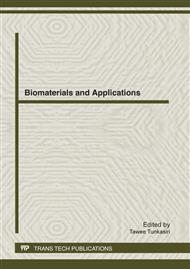p.367
p.371
p.375
p.381
p.385
p.389
p.393
p.397
p.401
The Gelation Study of Silk Fibroin for Biomedical Application
Abstract:
Silks are the biomaterials that have been used for a century. Most of them are related to the biomedical applications especially silk fibroin. Since the gelation process of silk fibroin was affected by many factors for example the concentration of silk fibroin protein, pH, temperature and cross-linking agent. These factors also influence on the mechanical properties of the silk gel. This study is then focused on making silk fibroin gel by using poly vinyl alcohol (PVA) as a cross-linking agent and physical induced by ultrasonic. The structure of SF/PVA gel was examined by Fourier Transform Infrared (FT-IR). The two main effects of ultrasonic and PVA to the silk fibroin gelation are the gelation time and the gel structure. The more ultrasonic power and PVA amount can make the silk fibroin solution becomes a gel faster. For the gel structure, both ultrasonic and PVA affect to the Amide I and Amide II structure which lead to the gel characteristic used as a wound dressing in the future.
Info:
Periodical:
Pages:
385-388
Citation:
Online since:
April 2012
Authors:
Price:
Сopyright:
© 2012 Trans Tech Publications Ltd. All Rights Reserved
Share:
Citation:


